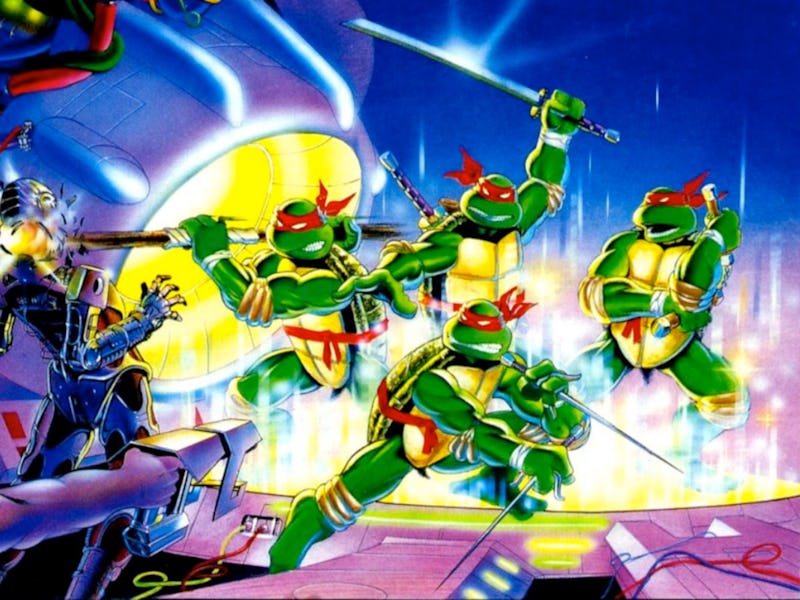35 Years Ago, A Beloved Cartoon Turned into One of the Most Frustrating NES Games Ever
It only gets better from here.

If you fondly remember playing Teenage Mutant Ninja Turtles games on the NES, you’re probably not thinking of the first one. Released on May 12, 1989, the original Teenage Mutant Ninja Turtles NES game rode the wave of the immensely popular 1987 cartoon show, and while it’s still a widely remembered part of the console’s history, that’s not because of its quality.
Teenage Mutant Ninja Turtles was the first released game based on the franchise, followed just a few months later by an arcade game of the same name. But while they share a title, the two games could hardly be more different. While the arcade game is remembered as a classic that gobbled up spare quarters at a breakneck pace — and got an NES port of its own a year later — the original is mostly remembered for being a garbage fire of frustrating controls and maddening difficulty spikes that still sold incredibly well, possibly due to the sky-high demand by kids for all things Turtles-related.
This level alone took years off my life.
The first thing that anyone who played Teenage Mutant Ninja Turtles on the NES likely remembers about it is its infamous water level. Early in the game, players are tasked with disarming eight bombs rigged to blow up a dam. An unforgiving time limit forces players to rush through this section before the bombs go off, while dodging fields of deadly seaweed that hurt just to touch. On top of that, the game’s generally crappy controls get even worse in the water, turning the entire swimming section into a frantic, barely controllable mad dash that seemingly tests players’ luck more than their skills.
And to some extent, that might actually be true. So much attention has been paid to the particular ways that Teenage Mutant Ninja Turtles sucks that it’s led to some extremely in-depth dissections of exactly why it sucks. In one, the YouTube channel Displaced Gamers takes a deep dive into the game’s code, showing how the sense of poor controls in the dam level is partially due to a water current effect pushing the player character at a random velocity around the map through its trickiest sections. Combined with some imprecise collision that can cause damage even when your character doesn’t make visible contact with that damn seaweed, it turns out there’s a good technical reason for why the level is so annoying. Even if some of the code discussion goes over your head — like it does for me — it’s a fascinating look into one of the most notoriously difficult levels in gaming.
According to players who got past the water level, it gets even worse from there, but like Battletoads’ equally notorious speeder bike level, the difficulty there is so extreme it’s likely the last thing most players saw in the game.
It’s not just you — the water level was a nightmare on a technical level.
Despite being an infuriating experience overall, Teenage Mutant Ninja Turtles sold extremely well for Konami, which makes sense given how much of a sensation the cartoon series was. It’s entirely possible that the strength of the show would have made sequels inevitable even if the first game was a total flop, but its success couldn’t have hurt in developer Konami’s calculations. Two more NES games based on Teenage Mutant Ninja Turtles would follow, then dozens more on other platforms.
Teenage Mutant Ninja Turtles in some ways exemplifies an era of tie-in games that didn’t really need to be good — or even that closely related to their source material — to succeed. The fact that it was a frustrating mess featuring enemies that don’t even appear in the cartoon had little bearing on its commercial success. Just being tied to a recognizable franchise was enough to make it a money-maker for its developer. The frenzy to release tie-in games of low quality is thought to be a major contributor to the video game industry’s crash in the early ‘80s, but by the end of the decade, the same tactics had started to work in publishers’ favor, no doubt helped by the fact that franchises like Teenage Mutant Ninja Turtles dominated pop culture in a way that made the name alone a near guarantee of success.
However negative its legacy is, Teenage Mutant Ninja Turtles on NES is also notable for introducing the turtles to video games, which has led to decades of games, almost all of which are better than the original. While recent hits like Teenage Mutant Ninja Turtles: Shredder’s Revenge trace their lineage more closely to the arcade game than the NES original, some credit is still owed to the first game out the gate for showing that games based on the series could be massive winners for their publishers. Fortunately, as games like Shredder’s Revenge shows, they’ve also gotten much better over time (and knocked it off with the water levels).